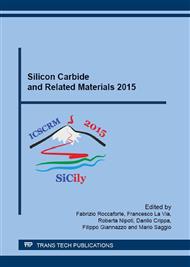p.553
p.557
p.561
p.565
p.569
p.573
p.577
p.585
p.591
Impact of Contact Material Deposition Technique on the Properties of Ti/4H-SiC Schottky Structures
Abstract:
In this paper, we report on the performance of Ti/4H-SiC Schottky junctions, whereas the contact material is either e-beam evaporated or magnetron sputter deposited. When applying the first technique, the Schottky barrier height is lowered at room temperature by about 80 meV or by about 160 meV extracted from current/voltage and capacitance/voltage measurements, respectively. Furthermore, e-beam evaporation of the Ti contact results in an ideality factor closer to 1 when comparing structures of the same design.
Info:
Periodical:
Pages:
569-572
Citation:
Online since:
May 2016
Authors:
Price:
Сopyright:
© 2016 Trans Tech Publications Ltd. All Rights Reserved
Share:
Citation:


